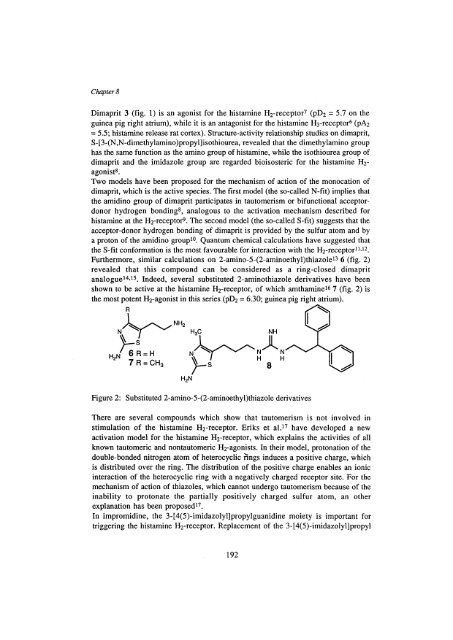synthesis and in vitro pharmacology of a series of histamine h2 ...
synthesis and in vitro pharmacology of a series of histamine h2 ...
synthesis and in vitro pharmacology of a series of histamine h2 ...
You also want an ePaper? Increase the reach of your titles
YUMPU automatically turns print PDFs into web optimized ePapers that Google loves.
Chapter 8<br />
Dimaprit 3 (fig. 1) is an agonist for the histam<strong>in</strong>e H2-receptor 7<br />
(pD2 = 5.7 on the<br />
gu<strong>in</strong>ea pig right atrium), while it is an antagonist for the histam<strong>in</strong>e H3-receptor 6<br />
(pA2 = 5.5; histam<strong>in</strong>e release rat cortex). Structure-activity relationship studies on dimaprit,<br />
S-[3-(N,N-dimethylam<strong>in</strong>o)propyl]isothiourea, revealed that the dimethylam<strong>in</strong>o group<br />
has the same function as the am<strong>in</strong>o group <strong>of</strong> histam<strong>in</strong>e, while the isothiourea group <strong>of</strong><br />
dimaprit <strong>and</strong> the imidazole group are regarded bioisosteric for the histam<strong>in</strong>e H2 agonist 8<br />
.<br />
Two models have been proposed for the mechanism <strong>of</strong> action <strong>of</strong> the monocation <strong>of</strong><br />
dimaprit, which is the active species. The first model (the so-called N-fit) implies that<br />
the amid<strong>in</strong>o group <strong>of</strong> dimaprit participates <strong>in</strong> tautomerism or bifunctional acceptordonor<br />
hydrogen bond<strong>in</strong>g 8<br />
, analogous to the activation mechanism described for<br />
histam<strong>in</strong>e at the H2-receptor 9<br />
. The second model (the so-called S-fit) suggests that the<br />
acceptor-donor hydrogen bond<strong>in</strong>g <strong>of</strong> dimaprit is provided by the sulfur atom <strong>and</strong> by<br />
a proton <strong>of</strong> the amid<strong>in</strong>o group 10<br />
. Quantum chemical calculations have suggested that<br />
1 !<br />
the S-fit conformation is the most favourable for <strong>in</strong>teraction with the Hrreceptor » 12<br />
.<br />
Furthermore, similar calculations on 2-am<strong>in</strong>o-5-(2-am<strong>in</strong>oethyl)thiazole 13<br />
6 (fig. 2)<br />
revealed that this compound can be considered as a r<strong>in</strong>g-closed dimaprit<br />
analogue 14<br />
* 15<br />
. Indeed, several substituted 2-am<strong>in</strong>othiazole derivatives have been<br />
shown to be active at the histam<strong>in</strong>e H2-receptor, <strong>of</strong> which amtham<strong>in</strong>e 16<br />
7 (fig. 2) is<br />
the most potent H2-agonist <strong>in</strong> this <strong>series</strong> (pD2 = 6.30; gu<strong>in</strong>ea pig right atrium).<br />
H 2N<br />
Figure 2: Substituted 2-am<strong>in</strong>o-5-(2-am<strong>in</strong>oethyl)thiazole derivatives<br />
There are several compounds which show that tautomerism is not <strong>in</strong>volved <strong>in</strong><br />
stimulation <strong>of</strong> the histam<strong>in</strong>e H2-receptor. Eriks et al. 17<br />
have developed a new<br />
activation model for the histam<strong>in</strong>e H2-receptor, which expla<strong>in</strong>s the activities <strong>of</strong> all<br />
known tautomeric <strong>and</strong> nontautomeric H2-agonists. In their model, protonation <strong>of</strong> the<br />
double-bonded nitrogen atom <strong>of</strong> heterocyclic r<strong>in</strong>gs <strong>in</strong>duces a positive charge, which<br />
is distributed over the r<strong>in</strong>g. The distribution <strong>of</strong> the positive charge enables an ionic<br />
<strong>in</strong>teraction <strong>of</strong> the heterocyclic r<strong>in</strong>g with a negatively charged receptor site. For the<br />
mechanism <strong>of</strong> action <strong>of</strong> thiazoles, which cannot undergo tautomerism because <strong>of</strong> the<br />
<strong>in</strong>ability to protonate the partially positively charged sulfur atom, an other<br />
explanation has been proposed 17<br />
.<br />
In impromid<strong>in</strong>e, the 3-[4(5)-imidazolyl]propylguanid<strong>in</strong>e moiety is important for<br />
trigger<strong>in</strong>g the histam<strong>in</strong>e H 2-receptor. Replacement <strong>of</strong> the 3-[4(5)-imidazolyl]propyl<br />
192

















